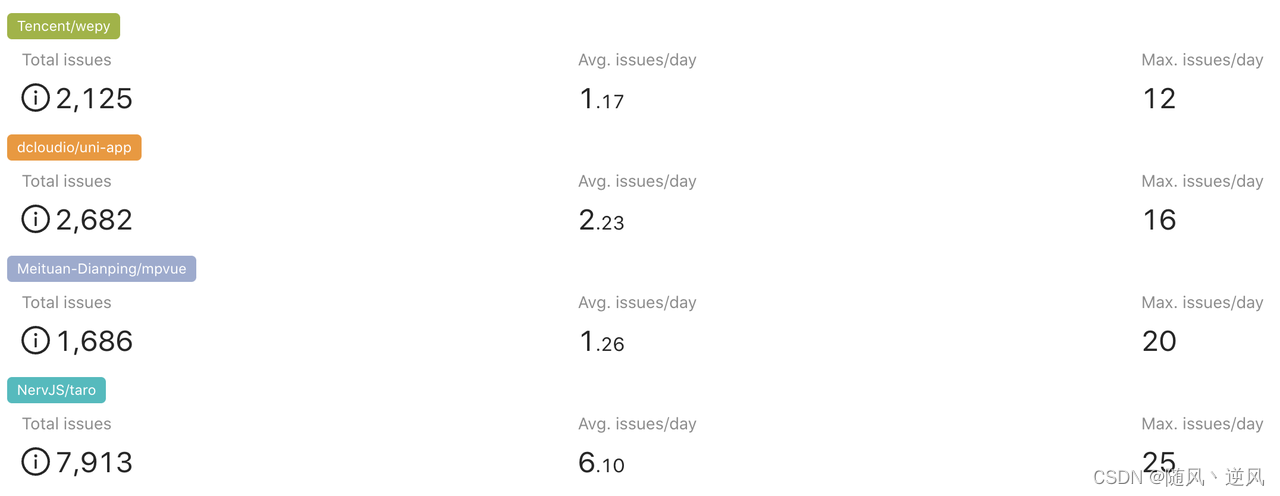At present, the popular open source frameworks for small programs include JD.com’s Taro, dclound’s uni-app (integrated with mpvue), Meituan’s mpvue and Tencent’s wepy. Below we compare these 4 frameworks from various aspects.
selection
Community ecology
The following data is obtained through Github Statistics
- maintenance status
It can be seen that uni-app and taro have been updated recently, and the latest submissions of wepy and mpvue have been several months ago.

2. Star
As of October 27, 2021, the overall situation is as shown in the figure below. As can be seen from the figure, the rising stars uni-app and taro are in the leading position.

| frame | Number of Stars | Star average growth |
|---|---|---|
| weps | 21566 | 11.93 |
| uni-app | 34051 | 28.32 |
| mpue | 20372 | 15.32 |
| taro | 29854 | 23.01 |
- Issues
Issues can reflect the activity level of the community. It can be seen that the taro issue is far ahead, indicating that the taro community is very active. Since the bug label is marked by the user himself, it is relatively inaccurate, but it can also be seen that uni-app feedbacks more bugs.

| frame | IssuesOpen/Close | bug tab on/off |
|---|---|---|
| weps | 344 / 1781 | 9 / 51 |
| uni-app | 827 / 1855 | 24 / 147 |
| mpue | 422 / 1264 | 3 / 22 |
| taro | 850 / 7063 | 7 / 76 |
Framework capability
| taro | uni-app | mpue | weps | |
|---|---|---|---|---|
| grammar specification | nerv, react, vue specification | vue-spec | vue-spec | class vue specification |
| template system | JSX | string template | string template | string template |
| type system | Business code + jsx template | Business code | Business code | Business code |
| Component specification | applet component | applet component | html tags + applet components | applet component |
| style specification | postcss、sass、less、stylus | postcss、sass、less、stylus | postcss、sass、less | sass、less、stylus |
| Componentization | react, vue componentization | Vue componentization | Vue componentization | Custom componentization |
| Multiplexing | Reuse as H5 | Reuse as H5 | Reuse as H5 | Reuse as H5 |
| automatic build | Built-in build system + webpack | Built-in build system + webpack | webpack | built-in build system |
| Startup cost | Familiar with react\vue | familiar with vue | familiar with vue | Familiar with vue+wepy |
| data flow management | redux | vuex | vuex | redux |
For each scenario, the best-performing code can be written natively, but the ROI is too low. The advantage of the framework lies in: writing more efficient code, having a richer ecology, and having good performance.
From the perspective of community ecology and framework capabilities, Taro is the best.
Realization principle
Taro 1/2 (heavy compile time, light runtime)
In order to achieve compatibility with multiple applets, it is divided into two stages:
-
Compilation stage: convert it into a template of the specified applet through babel;
-
Operation phase: through the runtime framework, it is responsible for adapting the underlying capabilities of each end.

This approach has several disadvantages:
- JSX is too flexible and expensive to adapt. (Although the analysis of react can be introduced, how can Taro use the "dog head" of React).
- source-map is not supported. Because Taro will transform the source code, source-map will not work. (could be handled during conversion, but too costly and low ROI)
- Strong binding to React DSL, once React has new features, it also needs to be adapted. As a developer, you can only upgrade to use new features.
- Because the AST needs to be manipulated frequently, the compilation speed will be slower.
Taro 3.x (light compile time, heavy runtime)
Use framework designs such as React and Vue to implement the relevant APIs required by render on different platforms. Simulate and implement DOM and BOM related APIs on the applet side, let the front-end framework run directly in the applet environment, so as to achieve the purpose of unifying applets and H5. As for the differences in life cycle, component library, API, routing, etc., by defining a unified standard, each end is responsible for its own implementation to smooth it out.

Due to the structural adjustment, Taro 3 is no longer strongly bound to a certain DSL, the development is more flexible, and the compilation speed is faster.
version difference
| Taro 1/2 | Taro 3.x | |
|---|---|---|
| Development experience | Strong binding to React DSL, and some JSX syntax is not supported (requires hack) | No DSL restrictions |
| performance | It is better in scenarios where the application is complex, there are many page nodes, and large-scale data updates are frequent | The above scene will be a little weaker, but the official said that the performance difference is not obvious. It also provides solutions such as pre-rendering and virtual list components |
| community support | Taro 1/2 will continue to be maintained, but with relatively less manpower | The focus of research and development is on Taro 3, giving priority to implementing new features |
reference documents
The Most Popular Small Program Boxes on GitHub in 2020
Small program framework comparison (Taro VS uni-app)
Mini Program Open Source Framework Selection-InfoQ
WeChat applet development framework comparison - Taro vs Remax
The Definitive Guide to Upgrading Taro Versions | Taro Documentation